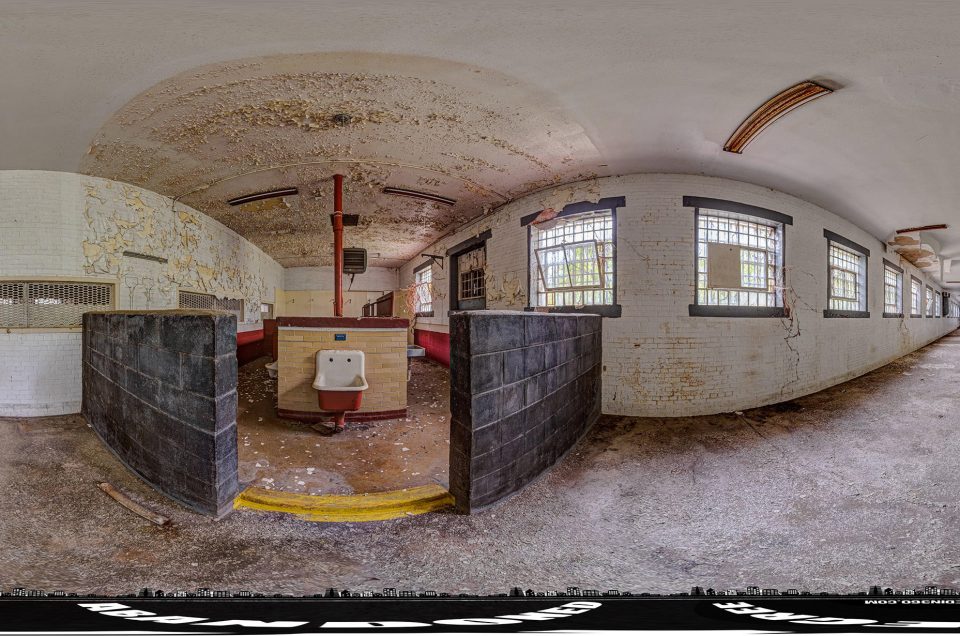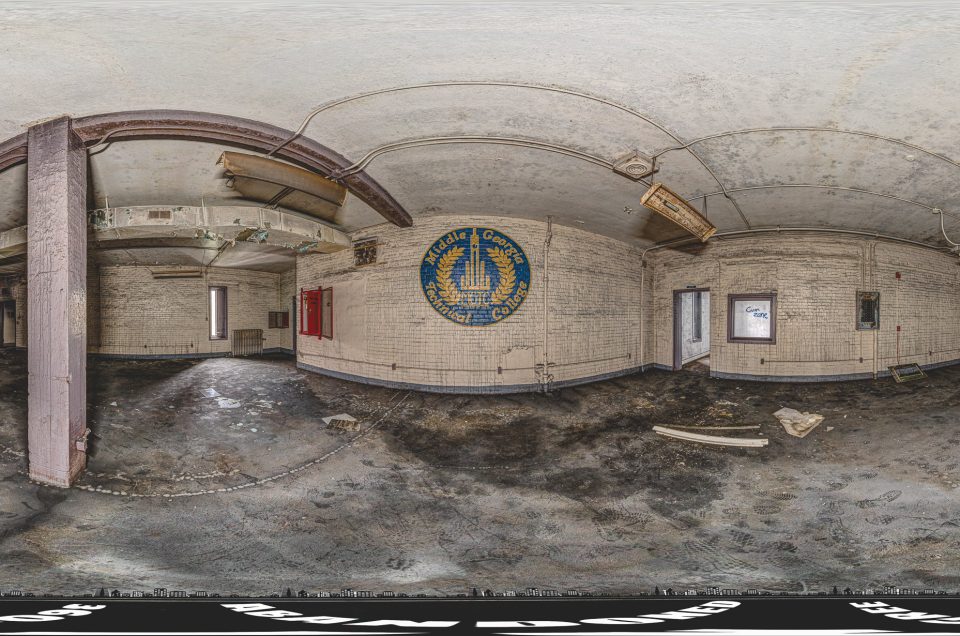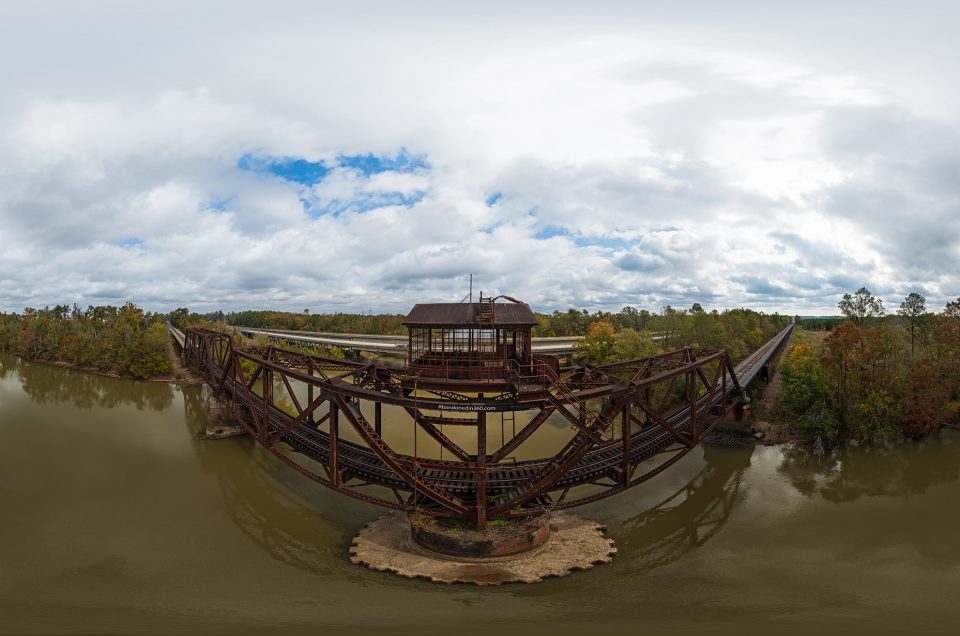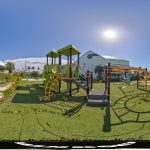Florida Highway Patrol Building: Exploring an Abandoned Orlando Landmark
Take a look at the Florida Highway Patrol Control Center in Orlando, Florida, where history and abandonment meet in fascinating ways. This once-active site served as a hub for monitoring and coordination, standing as a reminder of how quickly time can transform the purpose of a building. For urban explorers, it offers a rare glimpse into the past, with walls that still carry the echoes of its operational days.
What makes this place especially captivating is the fourteen immersive 360-degree panoramic views available for exploration. These visuals allow you to step inside virtually, experiencing the atmosphere of the Florida Highway Patrol Control Center from every angle. It’s a chance to study the details, textures, and decay up close—without ever leaving your screen—making it a true treasure for anyone fascinated by abandoned in Florida sites and the world of Urbex.
Click here to view it in fullscreen.
A Forgotten Fortress in the Heart of Orlando
In the hustle of Orlando’s east side, an imposing concrete building sits quietly fading from memory. Once a bustling government hub, the Florida Highway Patrol Building now stands abandoned – a tantalizing time capsule for those passionate about urban exploring in Florida. Its mid-century walls, now etched with peeling paint and creeping vines, hint at decades of history sheltered within. This site is among the intriguing places abandoned in Florida that beckon adventurers with its blend of historical significance and eerie serenity. Walking up to its padlocked gates and sun-bleached façade, you can almost imagine the daily buzz that once filled this facility. From state troopers rushing to patrol the highways to citizens lining up for driving tests or business permits, this building was a stage for countless everyday dramas. Now, it offers a different kind of story: one of dust-filled corridors, silent offices, and the echoes of a bygone era.
A Brief History of the Florida Highway Patrol Building
Opened in 1958, this Orlando complex was originally constructed as a state government facility. Its primary structure – a single-story, concrete block office spanning over 60,000 square feet – was built to serve the growing needs of Florida’s mid-century boom. Back then, Orlando was on the cusp of major growth, and the state responded by establishing this large regional center. In its early years, the building was a regional service center for Florida’s government, housing agencies that provided vital public services. Notably, it became home to the Florida Department of Business and Professional Regulation (DBPR)’s Regional Service Center, where citizens and professionals came for licensing, permits, and regulatory assistance.
Throughout the 1960s and 70s, as Central Florida’s population expanded, the building’s halls saw steady foot traffic. Locals even recall taking their driver’s license road exams from this very site decades ago, using the busy avenues nearby as testing grounds. Indeed, the property’s location – along a major Orlando thoroughfare not far from the executive airport – made it ideal for such civic uses. By the 1980s, this facility was a well-known state government outpost, a place where one might register a new business, attend a public hearing, or receive law enforcement services under one roof.
A Multi-Agency Government Hub
One remarkable aspect of the Florida Highway Patrol Building is how it evolved into a multi-agency hub over time. As Florida’s government restructured and grew, different departments cycled through this space. The DBPR’s presence in the building lasted through the mid-1990s, underscoring its importance as a center for business and professional affairs. But big changes were on the horizon.
In 1997, the state put the property up for sale, recognizing the high value of its prime 6.5-acre commercial location. The response was overwhelming – at least 16 potential bidders from across Florida (Orange, Pinellas, and Miami-Dade counties) showed interest, according to contemporary Orlando news reports. Clearly, this was considered “a hot piece of property,” centrally located on a busy route toward Orlando International Airport and just two miles from Orlando’s Executive Airport. However, despite the flurry of 1997 bids, the site ultimately remained in state hands. Rather than being sold off to private developers at that time, the decision was made to repurpose the facility for continued public use – a fortunate twist that set the stage for its next life with the Florida Highway Patrol.
By the late 1990s and early 2000s, the venerable complex found new purpose as a base for Florida’s highway guardians. The Florida Highway Patrol (FHP) moved its Orlando-area operations into the building, transforming it into Troop D’s headquarters and station. For the next two decades or more, this would be the nerve center for troopers patrolling Central Florida’s highways. Every day, state troopers convened here to roll out on shifts monitoring Interstate 4 and surrounding roads, conduct safety training, process accident reports, and coordinate responses to roadside emergencies. The facility housed offices for FHP command staff and dispatchers, an evidence storage area, and likely even space for trooper training classes. In essence, it became the law enforcement heartbeat of the region, linking Orange and surrounding counties under Troop D’s watch.
At the same time, the Florida Department of Transportation (FDOT) established a significant presence in the building. FDOT’s District 5 (which covers Central Florida) maintained an “Urban Office” on-site, using part of the facility for transportation planning and operations. Throughout the 2000s and 2010s, it was not uncommon for the complex to host public workshops and meetings about road projects and transit improvements. In fact, locals came to refer to the site simply as the “Florida Department of Transportation Building,” reflecting FDOT’s active use of the space for offices and community meetings. The building’s large auditorium and ample parking (nearly 286 spaces on the grounds) made it ideal for gatherings ranging from Complete Streets workshops to regional planning sessions. This dual identity – as both an FHP headquarters and an FDOT urban office – cemented the building’s role as a critical hub of public service. It was a place where a member of the public might one day attend a transportation hearing about a new highway and the next day return to file paperwork after a traffic accident – truly a one-stop nexus for transportation and safety matters.
Life Inside the Walls: Daily Activities and Bustling Scenes
During its heyday, the Florida Highway Patrol Building hummed with daily activity. One wing might host uniformed state troopers plotting their highway patrol routes, while another wing housed engineers and planners from FDOT poring over road maps. The blending of functions gave the site a unique energy. In the mornings, FHP cruisers lined up in the parking lot as troopers began their shifts. Radios crackled in the communication center, dispatching units to incidents on I-4 or Florida’s Turnpike. In other offices, civilians and officers worked side by side processing driver’s licenses, vehicle registrations, and paperwork for traffic citations – because the Department of Highway Safety and Motor Vehicles (of which FHP is a part) likely offered some licensing services here as well. For many years, locals knew this spot as a place to take care of practical tasks: perhaps to take a driver’s test or to attend a defensive driving course supervised by FHP officers.
Meanwhile, the FDOT staff used their section of the building to coordinate transportation initiatives across Central Florida. They managed projects improving road safety and reducing congestion, working closely with FHP on traffic management. At times, the building’s meeting rooms were filled with city and county officials, planners, and concerned citizens discussing everything from new highway interchanges to pedestrian safety. The synergy between FHP and FDOT under one roof meant that a truck crash on the highway or a hurricane evacuation plan could be addressed collaboratively in real time. Historical records indicate the building even contained a Traffic Management Center at one point, where live feeds from roadside cameras were monitored to respond swiftly to accidents or congestion – a precursor to today’s modern traffic control centers.
For the everyday people who passed through its doors, the building was a place of important life moments and civic duties. New trooper recruits might report here on their first day, nervous in their crisp uniforms. Nervous teenagers arrived with parent in tow for their driving exams, hearts pounding as they started the car outside the Highway Patrol station to prove their skills. Small business owners visited the DBPR counters (when that agency was here) to secure licenses for opening restaurants or salons, walking out with a sense of accomplishment and a paper in hand. Each interaction added to the rich tapestry of stories echoing within these halls.
Over the decades, notable events inevitably touched this place. Troopers based at the Semoran Boulevard station responded to major incidents on Central Florida roads – from massive interstate pileups to hurricane evacuations – coordinating efforts that saved lives. In the 2000s, when Orlando’s population and tourism swelled tremendously, the men and women working in this building bore witness to that growth. They managed the traffic of millions of visitors, from space shuttle launch spectators driving through town to the influx of tourists headed to theme parks, ensuring safety on the highways. Through it all, the building stood as a steadfast operations center, its modest one-story profile belying the vital work happening inside.
Decline: An Outdated Home for Modern Agencies
By the 2010s, however, the cracks were beginning to show – both literally and figuratively. After more than half a century of service, the Florida Highway Patrol Building was aging. Its 1958 construction, while sturdy, no longer met many modern standards. The wiring and communications infrastructure struggled to keep up with 21st-century technology. Offices designed in a mid-century era were now considered cramped and inefficient for contemporary needs. Florida’s law enforcement and transportation demands had also outgrown what the facility could support. Troop D had expanded over the years, handling one of the busiest regions in the state. Yet their headquarters remained in an old building that some insiders described as “super old” and insufficient for the growing team’s needs – essentially, a too-small, outdated space for a very big job.
Maintenance of the aging structure became a constant battle. Tropical Florida’s climate had not been kind to the facility – the humid summers and occasional hurricanes left their mark. The roof needed frequent patching to stop leaks. The air conditioning system, an absolute necessity in Orlando’s heat, was antiquated and prone to breakdowns. Every time a powerful thunderstorm rolled through, staff worried about how the old building would hold up. Moreover, lurking behind walls and under floors were likely the typical hazards of older buildings: asbestos insulation, aging pipes, perhaps even a few resident critters that found their way into less frequented corners. Renovating the complex to modern standards would have been an expensive and complicated project for the state.
Florida’s government began to plan for a future beyond the Semoran Boulevard site. FDOT District 5 had by then built up its primary headquarters elsewhere (in DeLand for district administration and a modern regional traffic management center in Seminole County), reducing the need for a large urban office in Orlando. The Florida Highway Patrol, for its part, started looking for a new home that could better serve as a Central Florida headquarters. After all, Orlando is a sprawling metro area, and having a location with easy access to major highways was critical. The old station, while centrally located in the city, was a bit landlocked in a busy commercial zone. A spot closer to the junction of key highways or more southern (to also cover fast-growing Osceola County) might serve better.
By the late 2010s, plans crystallized for FHP’s move. A new facility was identified on International Drive, Orlando’s famous thoroughfare, which incidentally placed the patrol closer to tourist corridors and the intersections of major expressways. In early 2023, Florida Highway Patrol officially opened a brand-new Troop D headquarters at 11059 International Drive. This state-of-the-art station provided modern dispatch centers, upgraded technology, and ample space for personnel – a stark contrast to the aging Semoran Blvd building. With that move, the long chapter of daily operations at the old building came to an end. After more than 60 years of continuous public service use, the lights were turned off, the doors locked, and the facility was retired.
Abandonment: A Sleeping Giant of Concrete and Memories
Once the FHP and FDOT vacated, the property slipped into silence, joining the ranks of large abandoned in Florida sites awaiting an uncertain fate. For the first time since 1958, the parking lot was empty of state vehicles. Weeds began poking through the cracks of the expansive pavement where patrol cars and commuters once rolled out daily. The windows, many now boarded or covered in dust, conceal interiors that have been left in a frozen tableau of the last day of operations. Inside, one might find remnants of its former life: a forgotten office chair here, a bulletin board still displaying a fading memo there, perhaps even a calendar on the wall forever turned to the month and year the building closed.
Walking the perimeter today, an urban explorer can observe how nature and time are slowly encroaching. Rust streaks mar the concrete block walls after countless rainstorms. The once meticulously maintained lawn has grown wild in patches, and the Florida sun has baked the beige exterior to a patchy gray. A state seal that likely adorned the lobby may have been removed, leaving a ghostly outline on the wall. Yet, other markings of the past remain – look closely and you may see the outline of old signage or the letters “FHP” and “FDOT” where they once hung proudly at the entrance.
Peer through a gap in a boarded window, and you’ll glimpse the shadows of cubicles and counters where citizens once stood for service. In the garage area (recall the secondary metal building, about 2,800 square feet, that sits on the property), tools and vehicle parts might still be strewn about, remnants of the fleet maintenance work that kept patrol cars on the road. Anecdotes from a few brave explorers and former employees suggest that some equipment and furniture was left behind in the haste of moving – file cabinets too heavy to relocate, old computer monitors, even a few defunct traffic signal parts stored by FDOT. There’s a sense that the building was mothballed rather than methodically emptied, giving it that eerie “Marie Celeste” vibe of a workplace suddenly abandoned.
For now, the site is secured by chain-link fencing and warning signs. The State of Florida, recognizing the property’s value, has been preparing to dispose of it. As of late 2024, the Division of State Lands of Florida’s DEP listed the property as surplus and initiated an auction process to sell it “as is” to the highest bidder. The minimum bid? A hefty $6.65 million, a price that reflects not only the sizable 6.12-acre lot in a busy commercial corridor, but also the decades of infrastructure sitting on it. Real estate documents note the complex includes all 63,465 square feet of building space in its current worn condition. What the future owner will do with it is anyone’s guess – perhaps demolish and redevelop, or maybe repurpose the solid old office structure for a new business. Until then, the Florida Highway Patrol Building exists in limbo, a sleeping giant of concrete filled with memories and dust.
Urban Explorer’s Perspective: The Allure and the Reality
For urban explorers, places like this offer an irresistible allure. Standing before the padlocked front entrance of the abandoned Florida Highway Patrol Building, you can’t help but feel a mix of curiosity and reverence. Here is a site where so many uniforms passed through and so many citizens sought help – now lying quiet, its story paused. The architecture is unadorned government utilitarian, but that only adds to the mystique. You won’t find lavish decor or extravagant design; instead, the beauty here is in the authenticity of decay and the layers of history.
Imagine slipping into a side door (in theory, of course – if one were to explore without trespassing) and finding yourself in a dim corridor where fluorescent lights once buzzed. Your footsteps echo on the tiled floor. On one wall, a large map of Florida is peeling at the corners, a pin still marking Orlando. Down another hall, you spot a whiteboard with faint marker notes about a “Troop Meeting – 9 AM” and an outdated year scribbled next to it. In the break room, a vending machine stands dark and empty; a forgotten coffee mug sits on a countertop covered in dust. Each artifact is a clue to the daily life that abruptly left this space.
The old lobby might be one of the most evocative spots. Here, decades of Floridians walked in with questions or problems and left with solutions (or sometimes tickets!). The reception window where a state employee once greeted visitors is now shattered, possibly by vandals or the elements. Behind the counter, strewn papers and forms give a sense of the bureaucratic processes that once ruled here – driver license applications, vehicle inspection forms, perhaps a manual for “HSMV procedures 2005.” An American flag might still stand in one corner on a stand, overlooked during the move, now covered in cobwebs – a silent guardian of the past.
However, any would-be explorer should know that venturing into this particular abandoned site comes with practical challenges. As an official state property, it is off-limits to the public, and trespassing laws are enforced. There have been reports of security patrols and even local police checking on the premises to deter vandalism or squatters. The building’s structural integrity, while generally sound, still poses typical risks: broken glass from windows, perhaps weak spots in the roof or floor, and definitely mold in the damp areas (a common issue in Florida’s abandoned buildings). Wildlife could have taken up residence too – it’s not unheard of to find snakes or stray cats in such places.
That said, even observing from the perimeter can be rewarding. Many urban explorers content themselves with exterior photography, documenting the way nature is reclaiming the site. The adventurous tone of exploration is still there as you walk around the boundary, imagining what lies inside. Some have noted the contrast between the busy modern city just beyond the fence – cars whizzing by, airplanes overhead – and the stagnant, frozen atmosphere within the property lines. It’s a reminder of how quickly times change: a facility that was once cutting-edge and essential can, in a matter of a few years, become an obsolete relic.
Future Prospects: The Next Chapter
As of now, the future of the Florida Highway Patrol Building remains unwritten. The state’s active auction indicates that change is on the horizon. If a sale goes through, this property could soon be in private hands for the first time in its existence. Many locals speculate on what will come next. Given the prime location along a major Orlando road (Semoran Blvd, also known as State Road 436), a buyer might choose to clear the land and build anew – perhaps a shopping center, offices, or even a mixed-use development to serve the growing city. Alternatively, the sturdy bones of the 1958 structure could be repurposed. We’ve seen other historic government buildings in Florida find new life as everything from business incubators to museums. Could this old state building be transformed into a unique office complex, or a training academy, or maybe an automotive center? Only time will tell.
For the community of urban explorers and history buffs, there is a bittersweet feeling. On one hand, redevelopment would mean the end of this particular abandoned Florida landmark in its current form – the loss of a time capsule that has stood for so long. On the other hand, change could bring an opportunity to honor the site’s legacy. Perhaps during redevelopment, historical markers or preserved elements could pay tribute to the Florida Highway Patrol and FDOT chapters of this building’s story. Imagine a plaque or small exhibit on-site detailing that “On this spot from 1958–2022 stood the headquarters of Florida Highway Patrol Troop D and a regional office of the Florida Department of Transportation,” ensuring that future generations passing by know about the public service history of the ground they’re walking on.
Conclusion: Preserving the Story of an Urban Relic
The tale of the Florida Highway Patrol Building in Orlando is a microcosm of Florida’s post-war growth, governance, and change. From its opening in 1958 as a beacon of progress in a developing city, through decades of dutiful service by multiple state agencies, to its present quiet abandonment, the building has been a witness to history. Its walls saw the evolution of transportation – from the era of two-lane highways and tail-finned Chevrolets, to the modern age of congested interstates and high-tech traffic control. They also bore witness to countless personal milestones: careers begun and ended, licenses earned, laws enforced and lives saved on the roads thanks to those who worked here.
For urban explorers, this site represents the essence of what draws us to abandoned places: the convergence of history, mystery, and the passage of time. It stands as a grey, hulking reminder that even the institutions meant to be permanent fixtures in our lives eventually change or relocate, leaving behind physical shells that we get to explore and interpret. In the broader landscape of urban exploring in Florida, the Florida Highway Patrol Building holds a special place – not for opulent architecture or infamous tragedy, but for its very ordinary, yet profound, legacy of public service.
As you stand at its fence line or, if fortune favors, wander cautiously through its vacant halls, take a moment to appreciate the profound stillness and reflect on what this building meant to the community. Each cracked tile and faded emblem has a story to tell. While the future will likely erase or reinvent this landmark, the adventurous souls who explore and document it today ensure that its story will not be forgotten. And so, the abandoned Florida Highway Patrol Building lives on – in photos, in memories, and in the annals of Florida’s ever-unfolding urban history – an enduring symbol of an era now past, yet not lost.
If you liked this blog post, you might want to learn about the Roxy Cinema and Grill in Florida, the Newark Priory in the United Kingdom or the massive Charles A. Cannon Jr. Memorial Hospital in North Carolina.
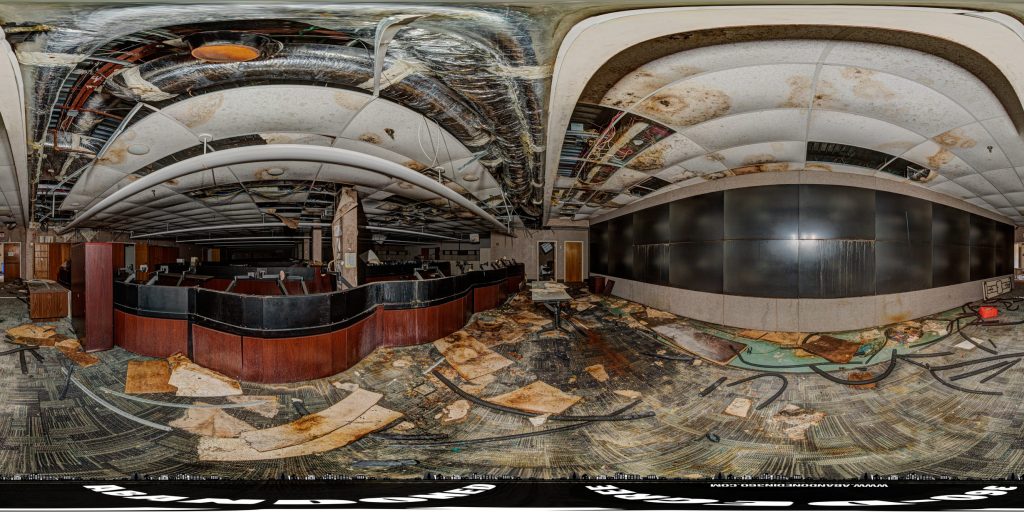
A 360-degree panoramic image inside an abandoned Florida Highway Patrol Control Center in Central Florida. Photographed by the Abandoned in 360 Urbex Team
Welcome to a world of exploration and intrigue at Abandoned in 360, where adventure awaits with our exclusive membership options. Dive into the mysteries of forgotten places with our Gold Membership, offering access to GPS coordinates to thousands of abandoned locations worldwide. For those seeking a deeper immersion, our Platinum Membership goes beyond the map, providing members with exclusive photos and captivating 3D virtual walkthroughs of these remarkable sites. Discover hidden histories and untold stories as we continually expand our map with new locations each month. Embark on your journey today and uncover the secrets of the past like never before. Join us and start exploring with Abandoned in 360.
Equipment used to capture the 360-degree panoramic images:
- Canon DSLR camera
- Canon 8-15mm fisheye
- Manfrotto tripod
- Custom rotating tripod head
Do you have 360-degree panoramic images captured in an abandoned location? Send your images to Abandonedin360@gmail.com. If you choose to go out and do some urban exploring in your town, here are some safety tips before you head out on your Urbex adventure. If you want to start shooting 360-degree panoramic images, you might want to look onto one-click 360-degree action cameras.
Click on a state below and explore the top abandoned places for urban exploring in that state.
